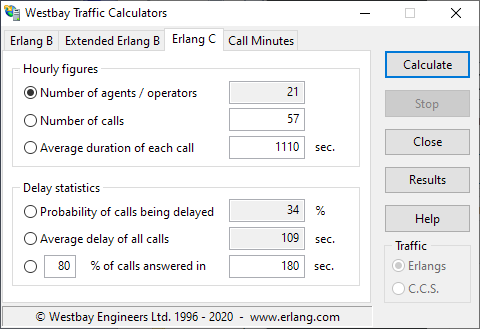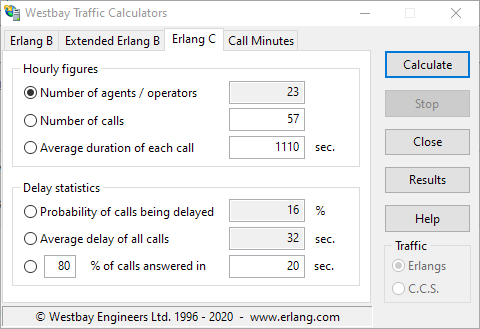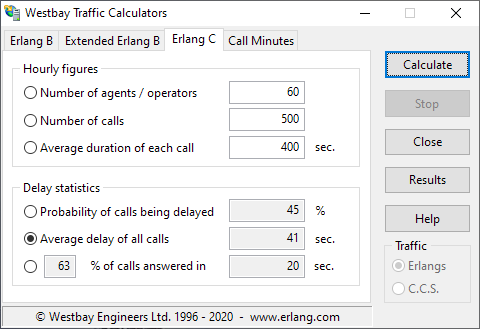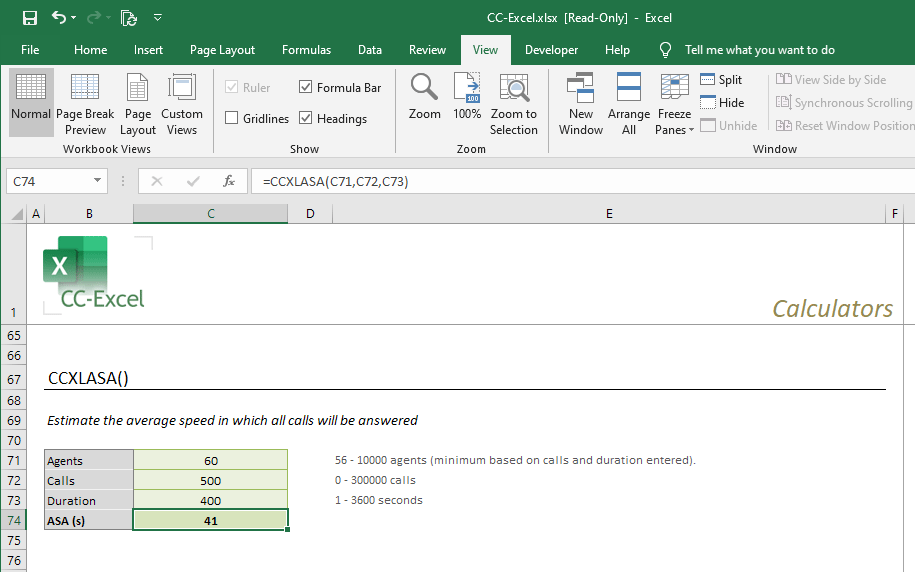Forum Replies Created
-
AuthorPosts
-
Tom Howard
KeymasterOur product, CC-Excel, accurately returns Erlang C calculations and applies them to call center analysis. I would imagine the other product does the same but you would need to check with its developer.
Regards,
Tom Howard,
Director,
Westbay Engineers Ltd.Tom Howard
KeymasterHello,
I’m not familiar with Super Gen Template. Are you using one of our Excel add-ins (Erlang for Excel or CC-Excel)? If so, please contact our support team who will be happy to send you new downloading and installation instructions.
Kind regards,
Tom Howard,
Westbay Engineers Ltd.Tom Howard
KeymasterYes, our calculators can be used in any environment or industry that handles inbound calls. There are no industry specific guidelines – use should be the same whatever industry you are in.
Tom Howard
KeymasterDifficult to answer, because the occupancy is what it is.
Imagine a motorway. You have a formula that works out how congested it becomes. You can make the motorway more congested by adding more cars (more calls to your centre) or closing a lane (reducing the number of agents).
You can estimate the occupancy using the CCXLAllBusy() function (see above) but occupancy will always be a result rather than an input.
Tom Howard
KeymasterThanks John.
“Below that rate, 75% the staff have too much time between calls and can be bored, get distracted and often develop other poor behaviours“
– that’s particularly interesting and not something a statistical model can take into account, of course.
Thank you for your kind comments about our products.
Tom H.
Tom Howard
KeymasterHi Shawn,
Westbay Traffic Calculators, which includes Erlang for Excel, is a more general Erlang calculation tool, offering Erlang B, Extended Erlang B etc. CC-Excel is specifically for call center calculations within Excel and support many types of reverse calculations to estimate performance (it adds nine call center functions to Excel.
We still sell both products.
Regards,
Tom Howard.Tom Howard
KeymasterHi again Sam,
The calculations is based on Erlang C , a long-established statistical model for analysing systems involving queuing. The algorithms are not our own and a quick google search will turn them up. They make some simple assumptions about the traffic, details of which can be found at the CC-Excel FAQ.
Calculations are traditionally done the other way round. In other words “how many agents do I need if I want 80% of calls answered within a specified time. We reversed the process for the CCXLService() functions. We have a Windows calculator called Westbay Traffic Calculators that includes Erlang C calculations. Out of interest, I ran your numbers through it to confirm the results matched those from CC-Excel. I also changed the target time to twenty seconds to see the effect, which was to increase the estimated agents required from 21 to 23. Here are some screenshots:
All the best,
Tom H.Tom Howard
KeymasterHello Sam,
CC-Excel functions all assume in their inputs and outputs that there is no shrinkage. In other words, that all agents are available for call answering all the time.
Kind regards,
Tom H.Tom Howard
KeymasterRichard,
That’s true. SWITCH() is a useful function. It’s probably easier to use than IFS() but has the following limitations:
- With SWITCH(), there can only be one expression being evaluated and you put it in the first argument. In my example, it would be C11. With IFS(), all of the conditons being tested can be unrelated, so:
If C11 equals 1, return this, otherwise
If G19 equals 2, return that
- The logical condition can only be = (equals). You cannot test > (greater than), < (less than) etc. Seems a silly omission to me.
I’ll put up a list of all the new functions introduced in Excel 2019 in another thread.
Tom Howard.
Tom Howard
KeymasterHi Jonathan,
My company produces and sells CC-Excel and I know it’s a great product – you wouldn’t expect me to say anything different. In truth, both products should show the same results because they’re both based on the Erlang traffic models . The operational limits of the two products may be different . CC-Excel has a simpler and slicker installation procedure – no manual installation of files required.
Really though, it comes down to the differences between any paid and free products. Making CC-Excel (and other products) is our job rather than a hobby. That gives us the incentive to make sure it works properly on the latest version of Windows and Excel. We react quickly to support queries and we provide that support and product upgrades for life. CC-Excel comes with comprehensive documentation and an example workbook.
Free and premium both have their place in this world.
All the best,
Tom Howard,
Director,
Westbay Engineers Ltd.Tom Howard
KeymasterHi,
I think you’re asking what proportion of a day’s traffic will be in the busy hour. That’s not something you can calculate; it’s something you need to estimate and it will depend upon many things: the industry you work in; the number of hours per day you handle calls; whether you have bursts of traffic in response to advertising campaigns.
The starting point I use is 17%, but you’ll need to work out your own figure. I assume that 17% of my daily traffic is during the busiest hour and I engineer my links for that hour. In that case, if my Busy Hour Traffic is 12 Erlangs, I would assume the daily traffic would be 12 / 0.17 Erlangs, which is 70.6 Erlangs. To convert that to minutes, multiply by 60 = 4235 minutes. In Excel, if the Busy Hour Traffic was in cell A1, my formula to work out total daily traffic would be =A1 / .17 * 60
More normally, you would work the other way. You would know the total daily traffic and need to convert the daily figure into a Busy Hour Traffic that Erlang B uses to estimate the lines required. The steps required are:
- Convert the minutes per day to hours per day by dividing it by 60.
- Work out the Busy Hour Traffic in Erlangs by applying a Busy Hour Factor (in my case, 17%).
- Apply that Busy Hour Traffic in Erlangs to the Erlang B formula to work out the number of lines you need.
I have made an Excel workbook to demonstrate the process:
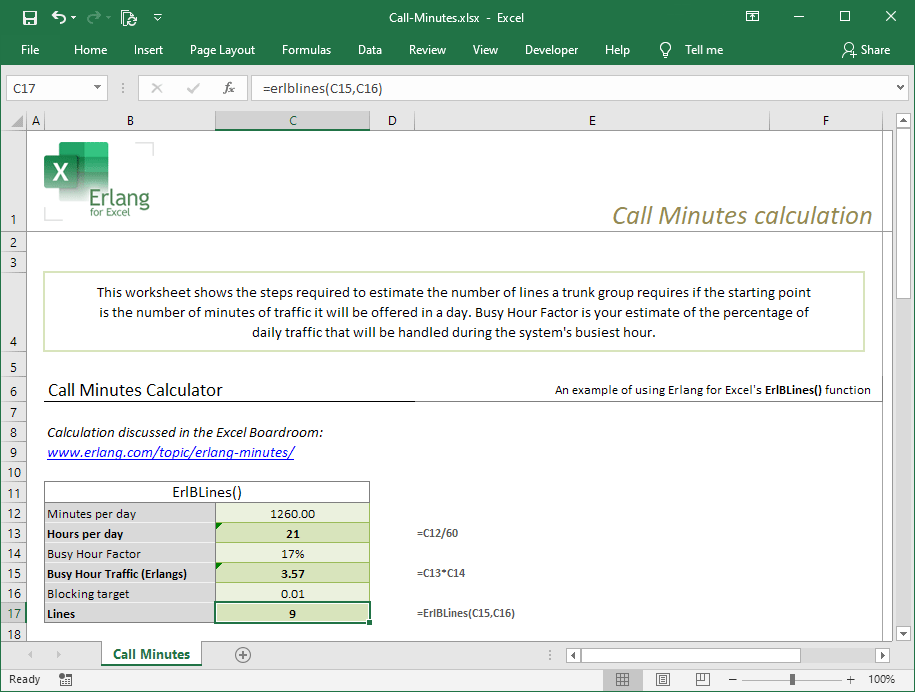
You can download this workbook (Call-Minutes.xlsx)
You will need Erlang for Excel installed in order for the =ErlBLines() formula to work.Tom Howard
KeymasterYes, we offer an Excel add-in called Erlang for Excel that adds Erlang functionality to your own spreadsheets. It adds these functions:
Erlang for Excel installs nine Erlang B and Erlang C functions into Microsoft Excel:
Function name Description ErlBLines() Estimates how many lines you need if you know your busy hour traffic. ErlBBlocking() Estimates the blocking a trunk group will experience. ErlBTraffic() Estimates the traffic that can be offered to your trunk group before blocking exceeds your target. ErlCAgents() Estimates how many agents you need to handle your incoming calls. ErlCCalls() Estimates how many inbound calls your agents can handle, keeping within your performance targets. ExtErlBLines() Same as ErlBLines, but takes call retries into account. ErlBBlocking() Same as ErlBBlocking, but takes call retries into account. ExtErlBTraffic() Same as ErlBTraffic, but takes call retries into account. For example, if you want a cell to show the number of lines required to keep to your blocking target of 0.01 and your Busy Hour Traffic is in cell B6, you would enter this formula into the cell:
=ErlBLines(B6,0.01)
Erlang for Excel is packaged with Westbay Traffic Calculators, an Erlang calculator for Windows. Together, they can provide your total Erlang calculation requirements, for life.
Tom Howard
KeymasterHi Jamie, Magnus is right that the SLA is extremely high with your example – pretty much perfect performance. That’s no surprise because you have 149 staff ready to answer only 1076 (fairly short) calls in an hour. To answer your more general question, our company offers an Excel add-in for call center analysis called CC-Excel. This adds several functions to Excel that you can use to estimate call center performance.
I’ve highlighted CC-Excel‘s SLA formulae below, in red:
Function name Description CCXLAgents() Estimates the number of agents you need to handle incoming calls within specified service level parameters. CCXLCalls() Estimates the number of calls that your inbound call center can handle within specified service level targets. CCXLDuration() Estimates the average length call that your call center can handle. CCXLASA() Estimates the average speed in which your center’s calls will be answered. CCXLQueue() Estimates the average number of your inbound calls that will be queued and waiting for presentation to an agent. CCXLOccupancy() Estimates the percentage of their time that your call center’s agents will be busy handling inbound calls. CCXLAllBusy() Estimates the percentage of calls that will arrive while all your agents are occupied, and will therefore enter a queue. CCXLService() Estimates the percentage of calls that will be answered within a specified service time. CCXLLines() Estimates the number of telephone lines that are required to handle the inbound calls into your call center. CC-Excel’s strength is the flexibility and freedom it gives you to design workbooks that meet your exact requirements, rather than being tied to the formats and assumptions of Windows workforce management applications. With some knowledge of Excel, you can use its more advanced features such as lookup tables, conditional formatting and charting to build complex modelling tools.
All the best,
Tom Howard,
Westbay Engineers Ltd.Tom Howard
KeymasterHello Jill,
Yes, it’s possible with two of the products we sell at this site.
We have a Windows product called Westbay Traffic Calculators. It has an Erlang C calculator that allows you to make these calculations (ASA from the number of agents, number of calls and call duration).
Here’s screenshot of Westbay Traffic Calculators in action:
If you prefer Excel workbooks, we made an add-in for Microsoft Excel called CC-Excel. It adds nine call center related functions to Excel. One of them is =CCXLASA() and it performs this calculation and, in line with all Excel functions, lets you reference other worksheet cells. In this case, references would be to cells that hold the number of agents, number of calls and call duration. The function result is the estimated ASA.
Here is an Excel screenshot showing the same calculation as before, but using CC-Excel:
More information on these products is available at:
Westbay Traffic Calculators: https://www.erlang.com/products/westbay-traffic-calculators/
CC-Excel: https://www.erlang.com/products/cc-excel/If you have any questions about these products, please reply to this post or email our support team directly: service@erlang.com
Kind regards,
Tom Howard,
Westbay Engineers Ltd.Tom Howard
KeymasterHello,
The Erlang C traffic model makes some assumptions about the nature of the traffic into a call center (see https://www.erlang.com/support/cc-excel-faq/). They include
– Call arrivals are random
– Service times are exponential
– Callers are answered in the order of arrivalIf call arrivals are not random, then Erlang C can tend to underestimate the agents needed. For example, if you have a sudden peak of calls, you’ll need more agents than normal to handle that peak.
If you’d like to send me some example figures, I can check them against our tools and make sure CC-Excel is giving you the expected results. My email address is service@erlang.com.
All the best,
Tom Howard,
Westbay Engineers Ltd. - With SWITCH(), there can only be one expression being evaluated and you put it in the first argument. In my example, it would be C11. With IFS(), all of the conditons being tested can be unrelated, so:
-
AuthorPosts



